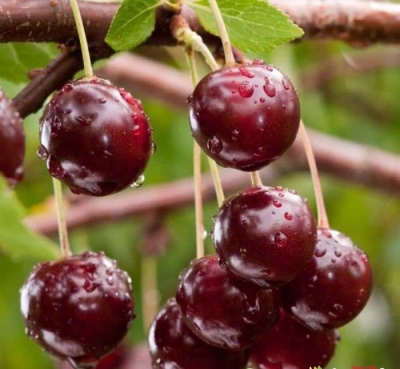
- Authors: L.I. Zueva, M.V. Kanshina, A.A. Astakhov (V.R. Williams All-Russian Research Institute of Feed)
- Year of approval: 2009
- Barrel type: wood
- Growth type: undersized
- Crown: spherical, spreading, round, thick, drooping
- Foliage: strong
- Escapes: medium, straight at the top, curved at the bottom
- Leaves: medium, oval, pointed, dark green, shiny, leathery, curved "boat", no pubescence
- Flowers: inflorescence - umbrella
- Fruit size: average
The Morel Bryanskaya variety is considered one of the best species for growing in an unstable climate. Cherry brings stable yields, tolerates summer drought and winter frosts well. Berries are consumed fresh, used for the preparation of compotes, conservation, freezing. Suitable for commercial cultivation.
Breeding history
The variety was obtained on the basis of the All-Russian Research Institute of Forage named after V.R. Williams by breeders L.I. Zueva, M.V. Kanshina, A.A. Astakhov. Included in the State Register in 2009.
Description of the variety
The tree is weak up to 2 m in height with a light bark, a spherical crown, spreading and strongly leafy. The leaves are medium-sized, oval, pointed, concave, dark green and shiny. Flowers up to 3 cm in diameter are collected in an inflorescence of 3-4 pcs. Flowering occurs in April-May. Fruiting begins to decline after 10 years.
Fruit characteristics
Berries of medium size, weighing 4.2 g, round, burgundy-red, almost black, medium-density pulp, juicy, tender skin, not very large stone. They are stored for about a week, they tolerate transportation well.
Taste qualities
Dessert taste, moderately sweet, with a slight sourness, sugar content - 9.1%, fruit acid - 1.4%, ascorbic acid - 14.2 mg per 100 g. Tasting score 4.5 points.
Ripening and fruiting
Begins to bear fruit 3-4 years after planting. The berries begin to ripen in mid-July, due to weather conditions, ripening times may shift.

Yield
10-12 kg are harvested from one tree.
Growing regions
Cherry is recommended for planting in Central Russia and Primorye.
Self-fertility and the need for pollinators
Partially self-fertile, without planting additional pollinators, the yield will be no more than 50% of the possible harvest volume. To obtain a bountiful harvest, they plant nearby: Amorel pink, Lotovka, Chernokorka.
Landing
The planting event is carried out in April, when the soil warms up to +10 degrees and warm weather sets in. They choose a bright place, protected from wind and drafts, preferably on the west or southwest side of the garden. Suitable for a plant: rich black soil, poor sandstone, loam. A seedling hole is dug 50-60 cm in size, 60 cm deep. Drainage is poured into the planting hole, and on top of a mound a nutrient mixture of compost, humus, garden soil and wood ash. Young trees are planted in the same way as other cherry varieties. The seedlings should be watered every week, weeds removed and the soil loosened.


Growing and caring
Fruiting trees are watered several times per season: necessarily during the flowering period, then when the fruits ripen and in the fall after leaf fall. The variety tolerates a lack of moisture well. Excessive waterlogging can lead to the appearance of fungal diseases. One plant takes about 2-3 buckets of water. After watering, they must loosen the soil, and in the fall they dig up the soil around the tree. For irrigation, I recommend using filtered water that does not contain harmful bacteria and fungal spores.
In addition, in the summer it is necessary to apply fertilizers - phosphorus and potash. In the spring, they are fed with nitrogen compounds - saltpeter, urea. Organic mixtures are applied once every 4 years in the fall during the digging of the site.
Forming, thinning and sanitary pruning is carried out every spring. Annual seedlings begin to form. The plant is cut at a height of 60-80 cm so that it has 4 strong branches on the trunk. In the second year, the central trunk is shortened by about 50 cm, 2-3 branches of the second tier are formed, the rest are shortened by 1/3. A ten year old tree needs rejuvenating pruning.


Disease and pest resistance
The variety has good immunity to the main cherry fungal diseases and pests. May be affected by coccomycosis and moniliosis. For prevention, it is recommended to carry out preventive treatments with a solution of copper sulfate or Bordeaux liquid in spring and autumn. To protect against aphids, weevils, cherry flies, folk remedies or popular insecticides are used: Karbofos, Iskra, Aktara.
Requirements for soil and climatic conditions
The variety is distinguished by good winter hardiness and frost resistance, tolerates temperatures down to -35 degrees. The seedlings are recommended to be insulated with straw and wrapped in burlap. In October, the soil under the trunk is dug to a depth of 10-15 cm and mulched with a layer of 10 cm, the stem is whitewashed. The most dangerous are winter thaws and subsequent frosts - after that the bark and branches freeze over. In regions where there can be significant temperature drops in winter, it is recommended to wrap the stem and skeletal branches with agromaterial.
Morel Bryanskaya gives stable yields in both dry and cold rainy seasons. The culture is undemanding to the composition of the soil.

Review overview
This is one of the favorite varieties of many summer residents, it is appreciated for its unpretentiousness and large sweet fruits.The tree winters well, and in summer, even on hot days, it does not need frequent watering.































































